| This article is incomplete. This article is missing one or more sections. You can help the BirdForum Opus by expanding it. |
Hopefully the contents of this page will help you learn the body parts and feather tracts of the bird population. It will enable you to write a good description assuming you see a rarity and have to submit a description, as well as understanding someone else's written description.
General Anatomy
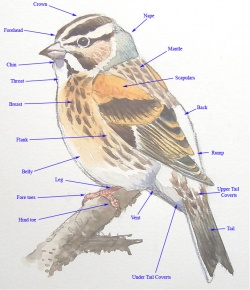
Tim's picture (right) shows a generalized passerine (perching bird), various parts of the body have been named as well as some of the feather tract names.
A couple of names that are used in some publications but are not shown on the drawing are retrices and remiges which refer to tail feathers and wing feathers respectively.
Coverts refer to feathers that cover other groups of feathers, wing coverts covering wing feathers and tail coverts the tail feathers.
Scapulars are the feathers of the shoulder and can be quite large in some birds.
Heads
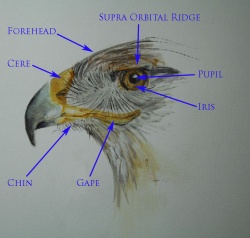
The picture (left) illustrates a ferruginous hawk and shows several features common to most raptors.
The cere is the bare area surrounding the nostrils and can be different colours according to species, age and sex of the bird.
The gape is the edge of the mouth and is most obvious in very young birds.
The iris can also vary in colour according species, age and sex.
The forehead can vary in angle of slope, whilst the supra-orbital ridge is what gives some birds the threatening appearance.
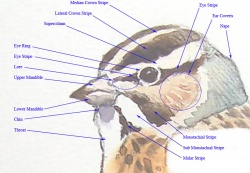
In this generalized passerine head (right) you can see several features that may not all be distinguishable on a real bird.
The crown stripes (median, lateral, supercilium and eye) and the cheek stripes (moustachial, sub-moustachial and malar) are shown in order to familiarize the reader with their relative positions, lots of birds will show only 1 or 2 of the stripes.
The two enclosed areas show the position of feather groups, which may or may not be different to the surrounding feathers, the lore is the area between the eye and beak whilst the ear coverts (also known as auricluars) are the feathers covering the ear opening.
Beaks

This image (left) shows the nail at the tip of the bill very well. This is a mallard, one of the dabbling ducks, however with the diving ducks the size and colouration of the nail can be a major identification feature. The upper mandible is sometimes known as the culmen.
Wings
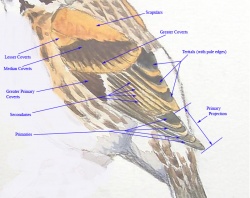
Tim's picture (right) shows a close up of a passerine wing, you can see the major feather groups, primaries, secondaries, tertials and coverts as they would appear when the wing is closed.
The Scapulars are the feathers of the shoulder region and can be moved to cover or reveal the feathers below. Tertials are the feathers closest to the body, Secondaries are flight feathers but not the main ones,Primaries are the main flight feathers. Coverts cover the secondaries and primaries when the wing is closed. See the picture of the mallard wing below for further information on the open wing.
Primary projection is the distance between the tip of the tertial feathers on the tip of the primary feathers, usually given as a ratio of the projection to the tertial length, vis. 1/2 tertials double the primary projection which is typical of Chiffchaff, whilst 3/4 (projection three quarters of tertial length) is more typical of Willow Warbler.

Dave's picture of a open wader wing (left) shows the feather groups as blocks of colour, this will make it easier to follow the feather groups when the wing is closed as shown on the following pictures.
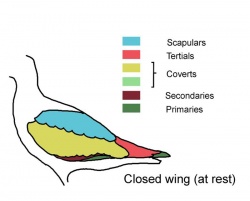
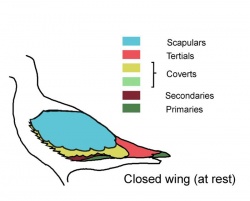
The picture of the closed wader wing (left) shows how the various feather group come together as the wing folds, you can see that the Scapulars lie over the Coverts (the primary coverts being totally covered) which in turn lie over the Tertials with only tiny areas of the Secondaries visible along with the tips of the Primaries. This is a typical view of a wader, however looking at the picture on the right you can see that the scapulars now cover most of the secondaries, in this instance the bird has opened the scapular feathers to cover more of the coverts. This is generally the case in cold weather when the bird is trapping more air beneath the feathers to act as insulation.
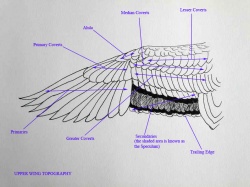
The picture of the mallard upper wing (left) shows the feathers of the open wing in more detail, you can see the alula (or bastard wing) which is a small group of feathers which act to prevent the bird's wing from stalling. Of more interest is the Speculum which is formed from the colour pattern of the secondaries, this is most important for identifying flying ducks. The colour pattern of the speculum being diagnostic for many species.
Feet
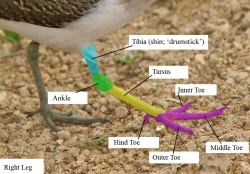
This picture shows the features of a wader's right leg, colour coded to make identification easier.
Between the outer toe and the middle toe you can just make out a small area of webbing, the presence or absence of webbing is sometimes used to aid identification of individual species.



